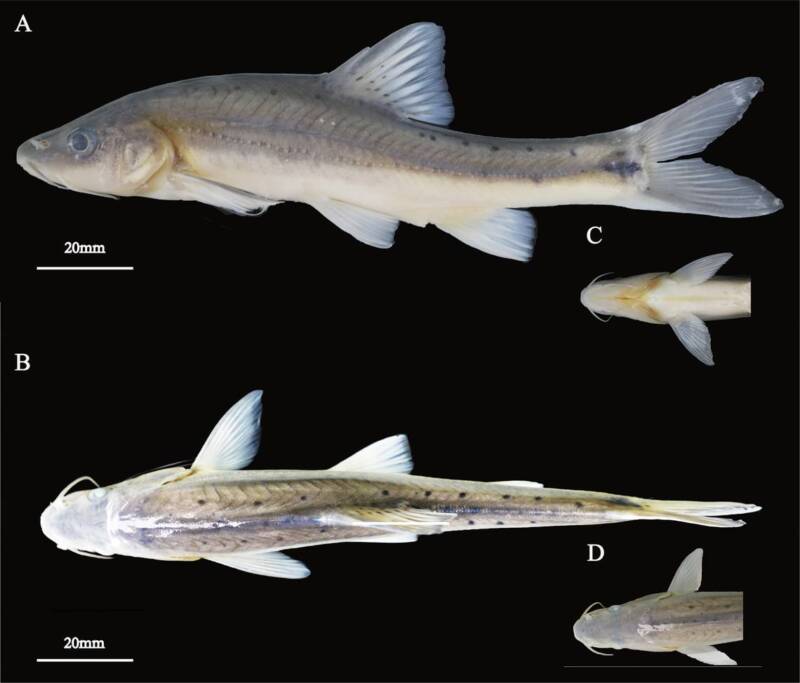“Unveiling the Mysteries of the Deep: A Stunning New Scaleless Golden Fish Discovered in Southwest China’s Enigmatic Caves!”
In the heart of China’s Guizhou Province lies a hidden gem that might just be the coolest fish you’ve never heard of: the Xingren golden-lined fish, scientifically dubbed Sinocyclocheilus xingrenensis. This little aquatic wonder, with its dazzlingly golden, scaleless skin and oversized peepers, is not just eye candy—it’s evolving right before our eyes! Picture this: a fish that has spent millions of years adapting to life in darkness, shedding its scales and embracing its cave-dwelling destiny. But what does that mean for its day-to-day drama in the underground waterways? As scientists study this newly discovered species, they’re unraveling how the absence of light and predators has molded its evolution. So, ready to dive deep into an evolutionary tale that’s literally too fishy to resist? LEARN MORE
The Xingren golden-lined fish lives only in caves near Xingren City, China, and the species is seemingly in the middle of evolving to adapt to its dark habitat.

Xiao M-Y, Wang J-J, Luo T, Zhou J-J, Xiao N, Zhou J/Zoosystematics and EvolutionThe golden scaleless fish discovered in a cave in China.
A remarkable golden fish has emerged from the caves of China’s Guizhou Province, offering a glimpse into millions of years of evolution.
Discovered during surveys conducted between 2012 and 2020, Sinocyclocheilus xingrenensis, or the Xingren golden-lined fish, has provided scientists with a unique opportunity to study evolution in isolation. With its distinct golden, scaleless body and large eyes, the species showcases a gradual adaptation to its dark cave environment.
Researchers are now using the Xingren golden-lined fish to better understand how environmental pressures, such as the absence of light and predators, have shaped the evolution of physical traits over millions of years.
Discovering A New Fish Species In A Chinese Cave
Between 2012 and 2020, researchers conducted fish studies in the waterways of Guizhou Province in southwest China. During this time, they collected seven specimens of a previously unknown cave fish.

Xiao M-Y, Wang J-J, Luo T, Zhou J-J, Xiao N, Zhou J/Zoosystematics and EvolutionOne of the cave habitats where the Xingren golden-lined fish lives.
This fish, measuring nearly six inches in length and sporting shiny gold skin and large eyes, was dubbed Sinocyclocheilus xingrenensis. It is the 81st fish species assigned to the genus Sinocyclocheilus.
The new species is physically distinct from its cousins with its golden, scaleless body, light-colored fins, and black markings. It also has two whiskers protruding from its face, similar to a catfish.
Scientists believe that the golden fish’s unique features are the result of its dark habitat, as it is “found only in caves near Xingren City,” researchers wrote in their study, now published in the journal Zoosystematics and Evolution. Because of its isolation, the golden fish has presented scientists with an invaluable opportunity to study the evolution of other fish species.
Exploring Fish Evolution Through The Xingren Golden-Lined Fish
Sinocyclocheilus xingrenensis is particularly distinct from many other freshwater fish due to its lack of scales. Research suggests that the fish gradually lost its scales over time due to the specific environmental conditions in its cave habitat.
But when did the species become scaleless? Researchers estimate that golden-line fish first entered caves towards the end of the Miocene epoch, roughly 23 million to 5.3 million years ago, when water levels in China started receding.

Xiao M-Y, Wang J-J, Luo T, Zhou J-J, Xiao N, Zhou J/Zoosystematics and EvolutionA preserved specimen of Sinocyclocheilus xingrenensis.
Then, during the Pleistocene epoch, between 2.6 million and 11,700 years ago, the species began losing its scales, pointing to a gradual evolution away from useless physical attributes in its new cave environment — like scales and working eyes. However, other fish species discovered in these caves have already lost both their scales and their eyes, meaning that Sinocyclocheilus xingrenensis may have arrived later in the caves than other golden-line fish.
“This further suggests that most cave fish may not have lived in cave ecosystems for more than a few million years,” the researchers wrote in their study. “Thus, together with the eyes and scales, we hypothesize that the new species may be undergoing a gradual evolutionary process towards caves.”
The Xingren golden-lined fish’s working eyes have also allowed researchers to paint a better picture of its day-to-day life. Unlike the blind fish who swim deep in the darkest recesses of the caves, this species may travel to cave entrances where light is still visible, thereby slowing down its evolutionary process.
“This is related to the habitat, where the new species can be connected to surface streams through cave windows, and their life rhythms may be closely related to [daylight periods],” the study authors wrote.
Research on the golden fish species continues, providing scientists with an invaluable opportunity to observe evolution in real time.



















